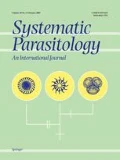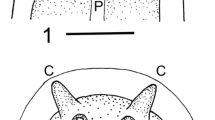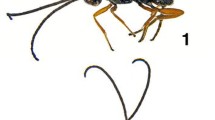Abstract
A new species of mermithid nematode, Hexamermis popilliae n. sp. (Nematoda: Mermithidae) is described from the Japanese beetle Popillia japonica Newman in Italy, an area of new introduction for this invasive pest. The combination of the following characters separates H. popilliae from other members of the genus Hexamermis Steiner, 1924: adult head obtuse; amphidial pouches slightly posterior to lateral head papillae in female but adjacent to lateral head papillae in males; amphidial openings large, well developed; amphidial pouches elliptical in females and oblong in males; cuticular vulvar cone well developed, vulvar lips greatly reduced or lacking, vagina curved at tip where meeting uteri, without reverse bend (not S-shaped), spicules slightly curved, with a slight bend in the basal portion, approximately equal to body width at cloaca. This is the first record of a species of Hexamermis parasitizing the Japanese beetle Popillia japonica. The only previous mention of mermithid nematodes from P. japonica was an undescribed species of Psammomermis in North America. Hexamermis popilliae will be evaluated as a potential biological control agent in an integrated control program of the Japanese beetle in Italy.





Similar content being viewed by others
References
Arijit, M., Khan, M. R., & Satpathi, C. R. (2005). Agamermis sp., a nematode parasite of Nephopteryx leucophaella (Pyralidae: Lepidoptera) from West Bengal. Annals of Plant Protection Sciences, 13, 266.
Artyukhovsky, A. K. (1990). [Soil mermithids; systematics, biology and utilization.] Voronezh, Russia: Voronezh University Publication, 158 pp (In Russian).
Baker, G. L., & Poinar, G. O., Jr. (1994). Studies of the genus Amphimermis (Nematoda: Mermithidae): five new species, including four from Orthoptera in southeastern Australia. Fundamental and Applied Nematology, 17, 303–322.
Bouckaert, R., Heled, J., Kühnert, D., Vaughan, T., Wu, C.-H., Xie, D., et al. (2014). BEAST 2: A Software Platform for Bayesian Evolutionary Analysis. PLoS Computational Biology, 10, e1003537.
Camino, N. (1989). Limnomermis bonaerensis sp. n. (Nematoda, Mermithidae), parásita de anfípodos (Crustacea, Malacostraca) en Argentina. Revista Iberica de Parasitología, 49, 227–231.
Castresana, J. (2000). Selection of conserved blocks from multiple alignments for their use in phylogenetic analysis. Molecular Biology and Evolution, 17, 540–552.
Darriba, D., Taboada, G. L., Doallo, R., & Posada, D. (2012). jModelTest 2: more models, new heuristics and parallel computing. Nature Methods, 9, 772–772.
Douda, O., Zouhar, M., Nováková, E., Mazáková, J., & Ryšánek, P. (2010). Variability of D2/D3 segment sequences of several populations and pathotypes of potato cyst nematodes (Globodera rostochiensis, Globodera pallida). Plant Protection Science, 46, 171–180.
EPPO (2014). First report of Popillia japonica in Italy. EPPO Reporting Service no. 10-2014 https://gd.eppo.int/reporting/article-3272. Accessed on April 2017.
Hagmeier, A. (1912). Beiträge zur Kenntnis der Mermithiden. Zoologische Jahrbücher Abteilung für Systematic, Ökologie, und Geographie der Tiere, 32, 529–612.
ICZN. (2012). International Commission on Zoological Nomenclature: Amendment of articles 8, 9, 10, 21 and 78 of the International Code of Zoological Nomenclature to expand and refine methods of publication. Zootaxa, 3450, 1–7.
Kaiser, H. (1991). Terrestrial and semiterrestrial Mermithidae. In: Nickle, W. R. (Ed.). Manual of Agricultural Nematology, New York: Marcel Dekker, pp. 899–965.
Kaya, H. K., & Stock, S. P. (1997). Techniques in insect nematology. In: Lacey, L.A. (Ed.), Manual of Techniques in Insect Pathology. San Diego, CA: Academic Press, pp. 281–324.
Klein, M. G., Nickle, W. R., Benedict, P. R., & Dunbar, D. M. (1976). Psammomermis sp. (Nematoda: Mermithidae): a new nematode parasite of the Japanese beetle, Popillia japonica (Coleoptera: Scarabaeidae) [Biological control]. Proceedings of the Helminthological Society of Washington, 43, 235–236.
Kobylinski, K. C., Sylla, M., Black, W., & Foy, B. D. (2012). Mermithid nematodes found in adult Anopheles from southeastern Senegal. Parasites & Vectors, 5, 131–131.
Kumar, S., Stecher, G., & Tamura, K. (2016). MEGA7: Molecular Evolutionary Genetics Analysis Version 7.0 for Bigger Datasets. Molecular Biology and Evolution, 33, 1870–1874.
Larkin, M. A., Blackshields, G., Brown, N. P., Chenna, R., Mcgettigan, P. A., Mcwilliam, H., et al. (2007). Clustal W and Clustal X version 2.0. Bioinformatics, 23, 2947–2948.
Li, Q., Sun, Y., Wang, G., & Liu, X. (2009). Effects of the mermithid nematode Ovomermis sinensis on the hemocytes of its host Helicoverpa armigera. Journal of Insect Physiology, 55, 47–50.
Manachini, B., & Landi, S. (2003). New record of Hexamermis sp. (Nematoda: Mermithidae) parasiting Rhaphigaster nebulosa Poda (Hemiptera: Pentatomidae). Bollettino di Zoologia Agraria e di Bachicoltura, 35, 91–94.
Marianelli L., Paoli F., Torrini G., Mazza G., Benvenuti C., Binazzi F., et al. Entomopathogenic nematodes as potential biological control agents of Popillia japonica (Coleoptera, Scarabaeidae) in Piedmont Region (Italy) (under review).
Nickle, W. R. (1972). A contribution to our knowledge of the Mermithidae (Nematoda). Journal of Nematology, 4, 113–146.
Paine, E. O., & Mullens, B. A. (1994). Distribution, seasonal occurrence, and patterns of parasitism of Heleidomermis magnapapula (Nematoda: Mermithidae), a parasite of Culicoides variipennis (Diptera: Ceratopogonidae) in California. Environmental Entomology, 23, 154–160.
Paoli, F., Marianelli, L., Binazzi, F., Mazza, G., Benvenuti, C., Sabbatini Peverieri, G., et al. (2017a). Effectiveness of different doses of Heterorhabditis bacteriophora against Popillia japonica 3rd instar larvae: laboratory evaluation and field application. REDIA, 100 (in press).
Paoli, F., Marianelli, L., Torrini, G., Mazza, G., Benvenuti, C., Bosio, G., et al. (2017b). Differential susceptibility of Popillia japonica 3rd instars to Heterorhabditis bacteriophora (Italian strain) at three different seasons. Biocontrol Science & Technology, 27(3), 439–444.
Poinar Jr., G. O. (1975). Entomogenous nematodes. Leiden: Brill. 317 pp.
Poinar Jr., G. O. (1977). CIH key to the groups and genera of nematode parasites of invertebrates. Bucks, England: Commonwealth Agricultural Bureaux, Farnham Royal. 43 pp.
Poinar, G. O., Jr. (1981). Thaumamermis cosgrovei n. gen., n. sp. (Mermithidae: Nematoda) parasitizing terrestrial isopods (Isopoda: Oniscoidea). Systematic Parasitology, 2, 261–266.
Poinar, G. O., Jr., & Benton, C. L. (1986). Aranimermis aptispicula ng, n. sp. (Mermithidae: Nematoda), a parasite of spiders (Arachnida: Araneida). Systematic Parasitology, 8, 33–38.
Poinar, G. O., Jr., Porter, S. D., Tang, S., & Hyman, B. C. (2007). Allomermis solenopsi n. sp. (Nematoda: Mermithidae) parasitising the fire ant Solenopsis invicta Buren (Hymenoptera: Formicidae) in Argentina. Systematic Parasitology, 68, 115–128.
Poinar, Jr. G. O. (2011). The Evolutionary History of Nematodes - as revealed in stone, amber and mummies. Brill, Leiden, 429 pp.
Potter, D. A., & Held, D. W. (2002). Biology and management of the Japanese beetle. Annual Review of Entomology, 47, 175–205.
Reid, D. G. (1974). New records of Hexamermis (Nematoda: Mermithidae) parasitizing three species of Slaterocoris (Hemiptera: Miridae). Canadian Entomologist, 106, 239–239.
Rubstov, I. A. (1970). A new species of mermithid from ants. Parazitologiya, 4, 338–341.
Stoch F. (Ed.) (2003) Checklist of the species of the Italian fauna. Online version 2.0. Available from: http://www.faunaitalia.it/checklist. Accessed on April 2017.
St. Onge, M., Larue, B., & Charpentier, G. (2008). A molecular revision of the taxonomic status of mermithid parasites of black flies from Quebec (Canada). Journal of Invertebrate Pathology, 98, 299–306.
Villemant, C., Zuccon, D., Rome, Q., Muller, F., Poinar, G. O., Jr., & Justine, J. L. (2015). Can parasites halt the invader? Mermithid nematodes parasitizing the yellow-legged Asian hornet in France. PeerJ, 3, e947.
Wang, J.-Y., Xu, F., Xu-Sheng, L., & Wang, G.-X. (2007). Molecular phylogeny of entomopathogenic nematodes (Mermithidae) inferred from DNA sequences of 18S rDNA, 28S rDNA and COI genes. Current Zoology, 53, 835–844.
Acknowledgements
We thank Andrei Legalov for translating from Russian to English a portion of the keys of Artyukhovsky (1990). Thanks to Simone Priori for the soil analysis and Andrea Taddei for his support during the samplings in Lombardy.
Funding
This work was carried out in the context of the National Project ‘ASPROPI - Activities for the protection of plants’ (Italian Ministry of Agricultural Food and Forestry, DM n. 28635, 2015/12/28), together with the regional project ‘COBIPO - Biological Control of Popillia japonica’ [Piedmont Region (D n. 910–2015/12/29)].
Author information
Authors and Affiliations
Corresponding author
Ethics declarations
Conflict of interest
The authors declare that they have no conflict of interest.
Ethical approval
All applicable institutional, national and international guidelines for the care and use of animals were followed.
Additional information
This article was registered in the Official Register of Zoological Nomenclature (ZooBank) as 61BCB3C6-8300-4149-9BD8-E5D157D19708. This article was published as an Online First article on the online publication date shown on this page. The article should be cited by using the doi number. This is the Version of Record.
This article is part of the Topical Collection Nematoda.
Rights and permissions
About this article
Cite this article
Mazza, G., Paoli, F., Strangi, A. et al. Hexamermis popilliae n. sp. (Nematoda: Mermithidae) parasitizing the Japanese beetle Popillia japonica Newman (Coleoptera: Scarabaeidae) in Italy. Syst Parasitol 94, 915–926 (2017). https://doi.org/10.1007/s11230-017-9746-0
Received:
Accepted:
Published:
Issue Date:
DOI: https://doi.org/10.1007/s11230-017-9746-0




